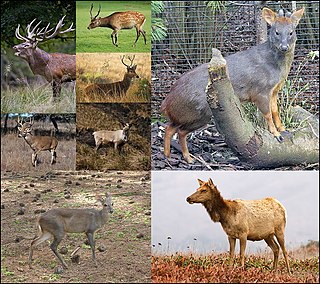
A deer or true deer is a hoofed ruminant mammal of the family Cervidae. The two main groups of deer are the Cervinae, including muntjac, elk (wapiti), red deer, and fallow deer; and the Capreolinae, including reindeer (caribou), white-tailed deer, roe deer, and moose. Male deer of all species, as well as female reindeer, grow and shed new antlers each year. In this, they differ from permanently horned antelope, which are part of a different family (Bovidae) within the same order of even-toed ungulates (Artiodactyla).
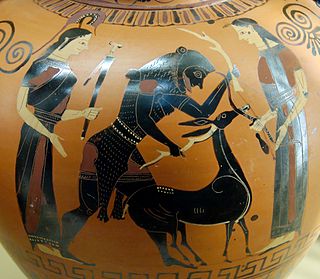
In Greek mythology, the Ceryneian hind, was a creature that lived in Ceryneia, Greece and took the form of an enormous female deer, larger than a bull, with golden antlers like a stag, hooves of bronze or brass, and a "dappled hide", that "excelled in swiftness of foot", and snorted fire. To bring it back alive to Eurystheus in Mycenae was the third labour of Heracles.
Annwn, Annwfn, or Annwfyn is the Otherworld in Welsh mythology. Ruled by Arawn, it was essentially a world of delights and eternal youth where disease was absent and food was ever-abundant. It became identified with the Christian afterlife in paradise.
In Welsh mythology and folklore, Cŵn Annwn (Welsh pronunciation:[kuːnˈanʊn], "hounds of Annwn"; singular Ci Annwn were the spectral hounds of Annwn, the otherworld of Welsh myth. They were associated with a form of the Wild Hunt, presided over by either Arawn, king of Annwn in Pwyll Pendefig Dyfed, the First Branch of the Mabinogi and alluded to in Math fab Mathonwy the Fourth Branch of the Mabinogi, or by Gwyn ap Nudd as the underworld king and king of the fair folk is named in later medieval lore.

The 4th World Scout Jamboree, a gathering of Boy Scouts from all over the world, was hosted by Hungary and held from 2 to 13 August 1933. It was attended by 25,792 Scouts, representing 46 different nations and additional territories. They encamped around the Royal Palace in the Royal Forest of Gödöllő, about 11 miles from the capital of Budapest.

Deer have significant roles in the mythology of various peoples located all over the world, such as object of worship, the incarnation of deities, the object of heroic quests and deeds, or as magical disguise or enchantment/curse for princesses and princes in many folk and fairy tales.

The white-tailed deer, also known commonly as the whitetail and the Virginia deer, is a medium-sized species of deer native to North America, Central America, and South America as far south as Peru and Bolivia, where it predominately inhabits high mountain terrains of the Andes. It has also been introduced to New Zealand, all the Greater Antilles in the Caribbean, and some countries in Europe, such as the Czech Republic, Finland, France, Germany, Romania and Serbia. In the Americas, it is the most widely distributed wild ungulate.

Melanism is the congenital excess of melanin in an organism resulting in dark pigment.

A piebald or pied animal is one that has a pattern of unpigmented spots (white) on a pigmented background of hair, feathers or scales. Thus a piebald black and white dog is a black dog with white spots. The animal's skin under the white background is not pigmented.
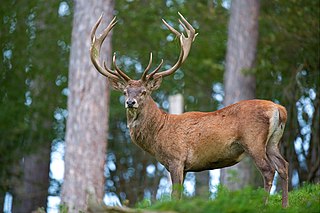
The red deer is one of the largest deer species. A male red deer is called a stag or hart, and a female is called a hind. The red deer inhabits most of Europe, the Caucasus Mountains region, Anatolia, Iran, and parts of western Asia. It also inhabits the Atlas Mountains of Northern Africa; being the only living species of deer to inhabit Africa. Red deer have been introduced to other areas, including Australia, New Zealand, the United States, Canada, Peru, Uruguay, Chile and Argentina. In many parts of the world, the meat (venison) from red deer is used as a food source.
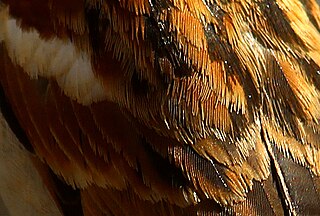
Plumage is a layer of feathers that covers a bird and the pattern, colour, and arrangement of those feathers. The pattern and colours of plumage differ between species and subspecies and may vary with age classes. Within species, there can be different colour morphs. The placement of feathers on a bird is not haphazard, but rather emerge in organized, overlapping rows and groups, and these feather tracts are known by standardized names.

The sambar is a large deer native to the Indian subcontinent, South China and Southeast Asia that is listed as a vulnerable species on the IUCN Red List since 2008. Populations have declined substantially due to severe hunting, local insurgency, and industrial exploitation of habitat.

The Questing Beast, or the Beast Glatisant, is a cross-animal monster appearing in many medieval texts of Arthurian legend and modern works inspired by them. In the French prose cycles, and consequently in the quasi-canon of Le Morte d'Arthur, the hunt for the Beast is the subject of quests futilely undertaken by King Pellinore and his family and finally achieved by Sir Palamedes and his companions.
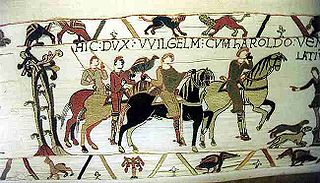
Royal hunting, also royal art of hunting, was a hunting practice of the aristocracy throughout the known world in the Middle Ages, from Europe to Far East. While humans hunted wild animals since time immemorial, and all classes engaged in hunting as an important source of food and at times the principal source of nutrition. The necessity of hunting was transformed into a stylized pastime of the aristocracy. More than a pastime, it was an important arena for social interaction, essential training for war, and a privilege and measurement of nobility. In Europe in the High Middle Ages the practice was widespread.
A white stag is a white stag or white deer.

Deer hunting is hunting for deer for meat and sport, an activity which dates back tens of thousands of years. Venison, the name for deer meat, is a nutritious and natural food source of animal protein that can be obtained through deer hunting. There are many different types of deer around the world that are hunted for their meat. For sport, often hunters try to kill deer with the largest and most antlers to score them using inches. There are two different categories of antlers. They are typical and nontypical. They measure tine length, beam length, and beam mass by each tine. They will add all these measurements up to get a score. This score is the score without deductions. Deductions occur when the opposite tine is not the same length as it is opposite. That score is the deducted score.
A white panther is a white specimen of any of several species of larger cat. "Panther" is used in some parts of North America to mean the cougar, in South America to mean the jaguar, and elsewhere to mean the leopard. A white panther may then be a white cougar, a white jaguar, or a white leopard. The genus name Panthera is a taxonomic category that contains all the species of a particular group of felids, but as a general term "panther" is also used for other felids, more commonly for melanistic individuals, but also for white or normally coloured individuals.

The White Stag Leadership Development Program, founded in 1958, is a summer leadership training program for youth 10 1/2–18 led by two California-based non-profits that sponsor leadership development activities. The teen youth staff of the two programs develop and produce several week-long leadership summer training sessions every year for several hundred youth from Central and Northern California and a few youth from other states and countries. The outdoors program is based on hands-on learning methods to develop competencies.


















